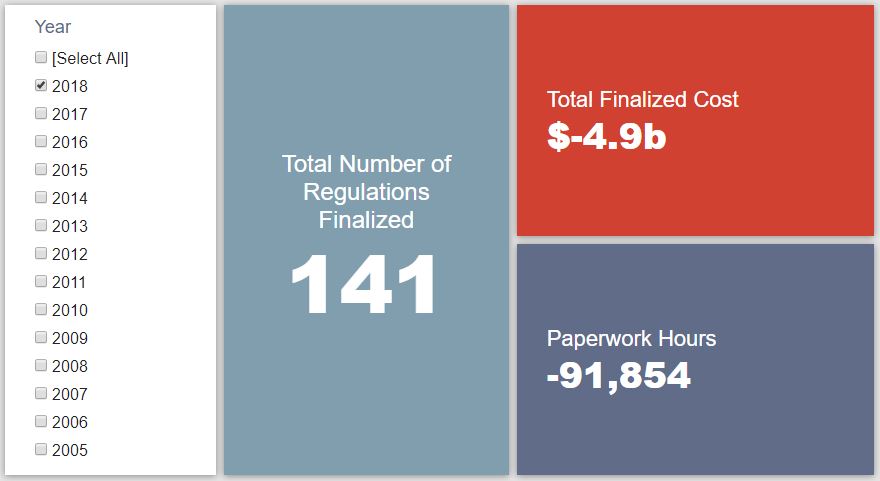Week in Regulation
July 9, 2018
Regulatory Proposals Lead the Way
Lead exposure and birds flying into airplane engines were the hazards du jour in the Federal Register last week. Proposed rules addressing both issues led an otherwise quiet week in rulemaking activity. Between both proposed and final rules, agencies published roughly $178.7 million in net costs, but cut 152,405 hours of paperwork. The per capita regulatory burden for 2018 is negative $14.90.
Regulatory Toplines
- New Proposed Rules: 34
- New Final Rules: 64
- 2018 Total Pages of Regulation: 31,406
- 2018 Final Rules: -$4.9 Billion
- 2018 Proposed Rules: $8.9 Billion
The vast majority of last week’s potential new costs came from a pair of proposed rules. The first was an Environmental Protection Agency (EPA) proposal to adjust “the current dust-lead hazard standards … from 40 μg/ft2 and 250 μg/ft2 to 10 μg/ft2 and 100 μg/ft2 on floors and window sills, respectively.” EPA expects this action to cost upward of $119 million per year, but also bring between $479 million and $2.24 billion in health benefits.
The other notable regulatory action comes from the Federal Aviation Administration (FAA). The proposed rule seeks to update the “Medium Flocking Bird Test at Climb Condition” to establish a more rigorous testing procedure. The agency estimates that these increased requirements could cost affected entities $71.5 million across 27 years against more than $100 million in lifetime safety benefits.
Tracking Regulatory Modernization
There was a trio of relatively modest deregulatory measures contributing savings towards the regulatory budget under Executive Order (EO) 13,771. One rule from the Department of Housing and Urban Development could save affected applicants nearly $60,000 annually due to streamlined paperwork requirements. The other two rulemakings are a pair of Department of Education (ED) actions to delay certain effective dates. ED estimates that such delays could provide savings of approximately $10.1 million and $7.8 million, respectively.
According to AAF analysis, since the start of FY 2018 (beginning Oct. 1, 2017), executive agencies have promulgated 44 deregulatory actions with quantified estimates against seven regulatory measures that impose costs, under the rubric created by EO 13,771 and the administration’s subsequent guidance document on the matter. These rules combine for net annual savings of roughly $1.2 billion. This means that agencies have thus far surpassed the administration’s cumulative goal for FY 2018 of $687 million in net annual savings. In fact, according to the administration’s latest Unified Agenda, agencies are on track to roughly double that goal.
Click here to view AAF’s examination of the administration’s progress under the “one-in, two-out” executive order through the end of Fiscal Year 2017.
State of Major Obama-Era Initiatives
Based on total lifetime costs of the regulations, the Affordable Care Act has imposed costs of $52.9 billion in final state and private-sector burdens and 176.9 million annual paperwork hours.
Since passage, the Dodd-Frank financial reform legislation has produced more than 82.9 million final paperwork burden hours and imposed $38.9 billion in direct compliance costs.
Total Burdens
Since January 1, the federal government has published $4.1 billion in net costs (despite $4.9 billion in net savings from final rules) and new paperwork burdens amounting to 2.2 million hours (including 91,854 hours of paperwork reduced under final rules). Click here for the latest Reg Rodeo findings.











